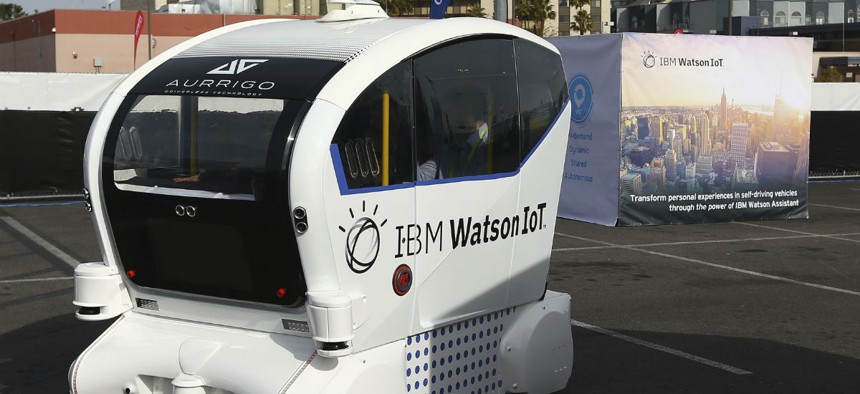Why Our Government Leaders Must Take the Wheel on Self-Driving Vehicles in 2019—and How They Can Do it

The IBM Watson IoT autonomous pod with Aurrigo Tech is voice-controlled on a closed course at CES International Jan. 8 in Las Vegas. Ross D. Franklin/AP
Such vehicles will enable older adults, people with disabilities and people who are housebound to get around with greater ease.
At CES® 2019, more than 170 vehicle technology exhibitors showcased the latest in self-driving technology—from Bosch’s all-electric, self-driving pod to Qualcomm’s 5G-enabled, self-driving chipset. These innovators underscored how self-driving technology will save lives, boost our economy and open a world of possibilities for passengers.
But for these benefits to be realized, we need a consistent national policy framework for self-driving technology.
More than 37,000 people died on U.S. roads in 2017—that’s more than 100 traffic deaths per day—and 94 percent of serious crashes are due to human error, according to the National Highway Traffic Safety Administration. Self-driving vehicles, or SDVs, can reverse these numbers.
SDVs will enable older adults, people with disabilities and people who are housebound to work, travel and visit loved ones with greater ease. And for those of us who do drive, SDVs will free up time spent behind the wheel and make getting around more productive and enjoyable. A report from the Ruderman Family Foundation estimates SDVs will result in a total savings of $1.3 trillion, due to productivity gains, fuel costs and fewer accidents.
Toward the end of 2018, Congress stood at the threshold of passing critical self-driving bills—the AV START Act and the SELF DRIVE Act—but failed to do so before the end of the legislative session. As Congress considers whether to act this session on self-driving policy, the Transportation Department has an equally important role to play, as do state governments across the country. If we want to lead the world on self-driving technology, here’s what must happen:
Think big. While the national conversation about SDVs has focused largely on passenger vehicles, this technology also has enormous implications for commercial vehicles. Self-driving commercial vehicles could dramatically increase the safety and efficiency of commercial goods transportation across our nation. These vehicles could also help bridge the current and projected shortage of commercial truck drivers across Transportation’s inclusion of commercial vehicles and trucks in AV 3.0 was an important first step. And, as the policy debate continues, Congress and individual states should resist blocking this technology in a misguided attempt to prevent job loss.
Think fast. Transportation has already taken a huge step in recognizing that many of its safety rules simply don’t apply when there’s not a human driver at the wheel. As it continues to update its approach, it must streamline its waiver, exemption and pilot program processes. The pace of technology innovation accelerates every day and the race to implement self-driving technology only grows more intense. Simplifying these critical processes will not only help us deploy this technology faster, it will also help us save money—and, more importantly, save lives.
Think broad. One of the biggest factors hindering the emergence of self-driving technology is regulatory overlap—when different agencies and different levels of government impose conflicting rules on the same technology. For example, SDVs will include digital technology that uses personal data—information traditionally protected by the Federal Trade Commission, not NHTSA. To avoid a patchwork effect, we need clear communication between state and federal leaders, between different federal agencies and between the public and private sectors.
Last century, cars were slowly but surely spreading across America, thanks to a government-industry partnership that built roads, bridges and highways, dramatically transforming our landscape and our economy.
Now, we need a similar partnership – one that will propel us into the future and drive us to new heights of safety, connectivity and prosperity for decades to come.
Gary Shapiro is president and CEO of the Consumer Technology Association, the U.S. trade association representing more than 2,200 consumer technology companies, and a New York Times best-selling author. His newest book, Ninja Future: Secrets to Success in the New World of Innovation, is available now. His views are his own.






